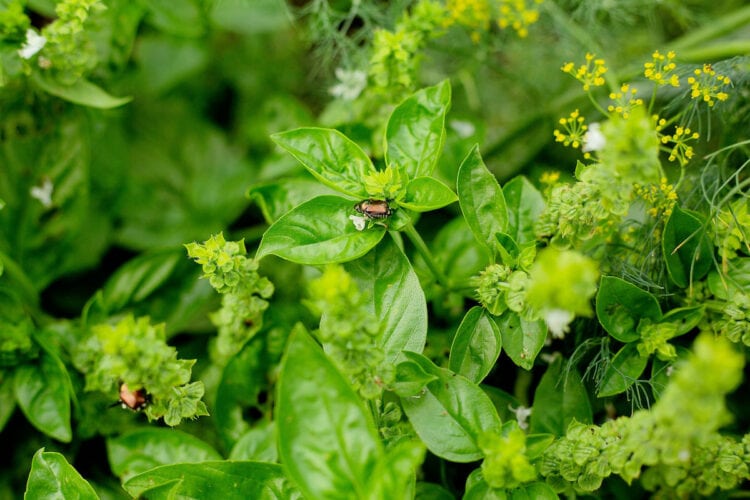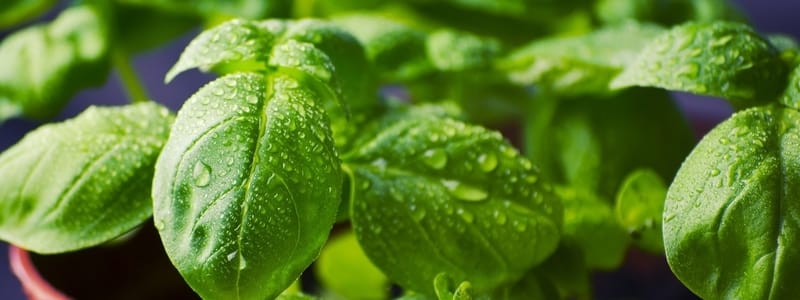Basil stands out as a cherished herb in many home gardens, prized for its fragrant leaves that elevate dishes from crisp salads to rich pasta sauces. It’s a culinary cornerstone worldwide. But did you realize that basil’s vitality, taste, and overall health can be significantly enhanced by pairing it with certain companion herbs? Companion planting involves growing plants close together to encourage growth, ward off pests, and amplify flavors. When done with care, it turns your garden into a lively ecosystem where herbs naturally support one another. This guide highlights five herbs that pair perfectly with basil, detailing how they enrich flavor, deter pests, and foster more robust, productive plants.
Why Companion Planting Benefits Basil
Basil flourishes when surrounded by compatible plants for several key reasons:
- Pest Control – Some herbs emit scents that repel aphids, mosquitoes, and other pests that commonly afflict basil.
- Flavor Enhancement – Companion herbs can alter basil’s chemical makeup, resulting in leaves with deeper, more complex aromas.
- Growth Support – Certain herbs attract helpful insects, improve soil health, or provide shade, all aiding basil’s development.
- Space Efficiency – Grouping herbs together optimizes garden space and creates a balanced mini-ecosystem.
By thoughtfully selecting basil’s plant partners, gardeners can cultivate healthier plants and enjoy more bountiful harvests without heavy reliance on chemical pesticides.
- Oregano: Your Natural Pest Defender
Oregano is more than just a tasty pizza herb—it’s a formidable ally for basil.
- Pest Deterrent – Its potent fragrance keeps aphids, thrips, and spider mites at bay, all of which threaten basil.
- Flavor Booster – Oregano’s presence can subtly enhance basil’s essential oils, making its scent more intense.
- Beneficial Insect Magnet – Oregano blossoms attract pollinators and predatory insects like ladybugs that help control harmful pests.
Planting Suggestions:
- Surround basil beds with oregano to form a natural protective barrier.
- Opt for compact oregano varieties to prevent overshadowing basil.
- Allow some oregano to flower to draw in helpful insects.
- Thyme: Amplifies Aroma and Plant Health
Thyme, a low-growing herb with a woody stem and strong fragrance, complements basil beautifully.
- Insect Repellent – Its scent discourages aphids, whiteflies, and cabbage worms.
- Growth Enhancer – Thyme’s shallow roots don’t compete aggressively for nutrients, letting basil thrive.
- Soil Health Promoter – Thyme fosters beneficial soil fungi, improving nutrient absorption for nearby plants.
Planting Tips:
- Plant thyme between basil plants to maximize pest protection.
- Choose trailing or compact thyme types to avoid shading basil.
- Regularly harvest thyme to encourage fresh growth and maintain its aroma.
- Parsley: Attracts Helpful Predators
Parsley is a versatile herb that works wonders when planted near basil.
Parsley: Nature’s Pest Controller and Soil Enhancer

- Attracts Beneficial Predators – Parsley lures helpful insects like ladybugs, lacewings, and parasitic wasps, which naturally keep aphids and other pests off your basil.
- Boosts Soil Vitality – Its roots help aerate the soil, enhancing water penetration and nutrient delivery to basil plants.
- Supports Pollinators – The nectar-rich flowers of parsley draw pollinators, indirectly aiding basil’s flowering and seed formation.
Planting Advice:
- Position parsley near the base of basil to prevent crowding.
- Choose between flat-leaf or curly parsley depending on your garden space and harvest needs.
- Maintain consistent moisture in the soil for both parsley and basil.
Chives: Flavor Enhancer and Pest Deterrent
- Repels Common Pests – Sulfur compounds in chives discourage aphids and Japanese beetles from invading basil.
- Elevates Basil’s Aroma – Basil grown alongside chives often develops a richer, more nuanced scent.
- Attracts Pollinators – Chive blossoms attract bees, promoting healthy basil blooms.
Planting Tips:
- Plant chives in clusters around your basil beds.
- Regularly trim chive flowers before seed formation to extend leaf production.
- Avoid overcrowding to ensure good airflow and reduce mildew risk.
Cilantro: Growth Booster and Root Protector
- Natural Pest Repellent – The strong fragrance of cilantro keeps aphids, spider mites, and leaf miners at bay.
- Stimulates Basil Growth – Compounds released by cilantro roots may encourage basil root development.
- Draws Beneficial Insects – Flowers attract parasitic wasps and hoverflies that help control pests.
Planting Guidelines:
- Sow cilantro near basil but allow enough space to prevent leaf overlap.
- Harvest cilantro frequently to avoid premature bolting.
- Use succession planting to maintain continuous pest control and growth support.
Additional Benefits of Companion Planting
- Microclimate Regulation – Taller herbs provide shade, protecting basil from intense heat and leaf scorch.
- Soil Moisture Conservation – Low-growing herbs like thyme and oregano act as living mulch, helping retain soil moisture.
- Enhanced Biodiversity – A mix of herbs attracts diverse insects, fostering a balanced garden ecosystem.
- Optimized Space Use – Combining vertical and horizontal growth habits maximizes yield per square foot.
Tips for Thriving, Flavorful Basil
- Choose Well-Draining Soil – Basil flourishes in rich, loamy soil that drains well.
- Ensure Ample Sunlight – Provide 6 to 8 hours of direct sun daily for robust growth.
- Maintain Consistent Moisture – Keep soil damp but avoid waterlogging to prevent root diseases.
- Prune Regularly – Pinch off flowers and harvest leaves to encourage bushier plants.
- Rotate Annually – Change herb locations yearly to avoid soil diseases and nutrient depletion.
Avoid These Common Gardening Pitfalls
Even when using companion herbs, gardeners can stumble on a few key mistakes:
- Crowding your plants – Herbs thrive when given enough room; tight clusters can lead to increased fungal infections.
- Mixing incompatible plants – For example, basil shouldn’t be planted near species that demand excessive nutrients or tall plants that block its sunlight.
- Overlooking soil conditions – Basil favors soil that is slightly acidic to neutral. Companion herbs with different soil needs may compete if the soil isn’t properly balanced.
- Skipping pest checks – While companion planting can deter pests, it’s still crucial to regularly inspect your garden for any signs of trouble.
Final Thoughts
Basil is a wonderfully adaptable and flavorful herb that flourishes when paired with the right companions. Herbs like oregano, thyme, parsley, chives, and cilantro not only boost basil’s taste but also shield it from pests and promote healthier growth overall. Employing companion planting techniques allows gardeners to cultivate a vibrant herb garden that reduces reliance on chemicals, enhances yields, and produces richly aromatic leaves. Success hinges on maintaining balance—adequate spacing, proper sunlight, consistent watering, and timely harvesting all play vital roles. When you grow basil alongside these five herbs, you’re nurturing a small ecosystem where each plant supports the others. The outcome is robust, flavorful basil and a garden that naturally thrives year after year.
Basil and Companion Planting
- Basil enhances many dishes and thrives with certain companion herbs.
- Companion planting promotes growth, repels pests, and improves flavor.
- Five key companion herbs: oregano, thyme, parsley, chives, cilantro.
Why Companion Planting Benefits Basil
- Pest management: repels aphids, mosquitoes, and other pests.
- Enhanced flavor: companion herbs enrich basil’s aroma.
- Improved growth: attracts beneficial insects, improves soil, provides shade.
- Efficient space use: creates a natural mini-ecosystem.
Key Companion Herbs
-
Oregano
- Repels pests like aphids and spider mites.
- Enhances basil’s fragrance.
- Attracts pollinators and predatory insects.
- Plant around basil beds; allow flowering.
-
Thyme
- Repels aphids, whiteflies, cabbage worms.
- Shallow roots avoid nutrient competition.
- Boosts beneficial soil fungi.
- Interplant with basil; harvest regularly.
-
Parsley
- Attracts predatory insects controlling pests.
- Aerates soil, improving nutrient flow.
- Supports pollination with nectar-rich flowers.
- Plant at basil base; keep soil moist.
-
Chives
- Repels aphids and Japanese beetles.
- Enhances basil’s flavor complexity.
- Attracts bees for pollination.
- Plant in clusters; manage flower growth.
-
Cilantro
- Deters aphids, spider mites, leaf miners.
- Stimulates basil root growth.
- Attracts beneficial predators.
- Space plants well; harvest to prevent bolting.
Additional Benefits
- Microclimate support: shade reduces leaf scorch.
- Soil moisture retention via low-growing herbs.
- Biodiversity boosts balanced ecosystems.
- Maximizes garden space efficiency.
Tips for Healthy Basil
- Use well-draining, rich soil.
- Provide 6–8 hours of sunlight daily.
- Water consistently, avoid waterlogging.
- Prune regularly to encourage growth.
- Rotate herbs annually to prevent disease.
Common Mistakes
- Avoid overcrowding to reduce fungal risks.
- Don’t plant incompatible or overly tall neighbors.
- Monitor soil pH and fertility.
- Continue pest monitoring despite companion planting.
Conclusion
- Companion herbs improve basil’s flavor, health, and pest resistance.
- Creating a balanced mini-ecosystem leads to stronger, more productive basil.
- Proper spacing, sunlight, watering, and harvesting are key to success.
